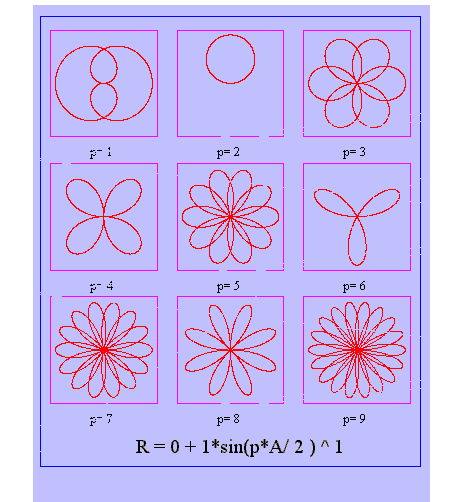Petals of R = sin(p*A)
Q01. Diagram : graph of R = sin(p*A)
Graph of R = sin(p*A)

|
Graph of R = cos(p*A)

|
Go to Begin
Q02. Prove that the graph of R = sin(p*A/2) has 2*p petals if p is odd
Graphic solution
- As shown in Figure 425, the proof is completed
- Number 3*A/2 ... Angle A .. Value R .. Plot angle .. (Direction of Petal)
- --------------------------------------------------------------------------
- 1 .... 090 ..... 060 ...... +1 ....... 060 ......... 60
- 2 .... 270 ..... 180 ...... -1 ....... 000 ......... 180 + 180 - 360 = 0
- 3 .... 450 ..... 300 ...... +1 ....... 300 ......... 300
- 4 .... 630 ..... 420 ...... -1 ....... 240 ......... 420 + 180 - 360 = 240
- 5 .... 810 ..... 540 ...... +1 ....... 180 ......... 540 - 360 = 180
- 6 .... 990 ..... 660 ...... -1 ....... 120 ......... 660 + 180 - 720 = 120
- 7 ....1170 ..... 780 ...... +1 ....... 180 ......... 780 -720 = 60
- Since petal number 1 and petal number 7
- The petal direction = 60 degrees with petal length = 1
- Hence it has 6 petals
- The cycle domain is (780 - 60) = 4*pi
- Angle A = 0 to 720 degrees
- Similary we can prove
- sin(5*A/2) has 10 petals with A = 0 to 4*pi
- sin(7*A/2) has 14 petals with A = 0 to 4*pi
- etc.
- Since 4.5 = 9/2
- R = sin(4.5*A) = sin(9*A/2)
- Hence the number of petals = 2*9 = 18 petals (See diagram)
Go to Begin
Q03. Prove that the graph of R = cos(p*A/2) has 2*p petals if p is odd
Graphic solution
- As shown in Figure 425, the proof is completed
- Number 3*A/2 ... Angle A .. Value R .. Plot angle .. (Direction of Petal)
- --------------------------------------------------------------------------
- 1 .... 000 ..... 000 ...... +1 ....... 000 ......... 0
- 2 .... 180 ..... 120 ...... -1 ....... 300 ......... 120 + 180 = 300
- 3 .... 360 ..... 240 ...... +1 ....... 240 ......... 240
- 4 .... 540 ..... 360 ...... -1 ....... 180 ......... 360 + 180 - 360 = 180
- 5 .... 720 ..... 480 ...... +1 ....... 120 ......... 480 - 360 = 120
- 6 .... 900 ..... 600 ...... -1 ....... 060 ......... 600 + 180 - 720 = 60
- 7 ....1080 ..... 720 ...... +1 ....... 000 ......... 720 -720 = 0
- Since petal number 1 and petal number 7
- The petal direction = 0 degrees with petal length = 1
- Hence it has 6 petals
- The cycle domain is (720 - 000) = 4*pi
- Angle A = 0 to 720 degrees
- Similary we can prove
- cos(5*A/2) has 10 petals with A = 0 to 4*pi
- cos(7*A/2) has 14 petals with A = 0 to 4*pi
- etc.
Go to Begin
Q04. Twin patterns : R = 1 + 1*sin(p*A/2) and R = 1 + 1*cos(p*A/2)
Graphic solution
- Twin patterns R = 1 + 1*sin(p*A/2) and R = 1 + 1*cos(p*A/2)
- The diagrams are no difference : The directions of petals are same
- But the direction are different if compare the direction
- ...................... sin .... cos
- 1st petal direction : 060 .... 000
- 2nd petal direction : 000 .... 300
- 3rd petal direction : 300 .... 240
- 4th petal direction : 240 .... 180
- 5th petal direction : 180 .... 120
- 6th petal direction : 120 .... 060
Go to Begin
Q05. Directions of petals of floral functions
1. R = sin(2*A) and R = cos(2*A) : 45 degree phase difference if A = 0, 2*pi
1. R = cos(2*A) : 0, 90, 180 and 270 degrees 2. R = sin(2*A) : 45, 135, 225 and 315 degrees2. R = sin(3*A/2) and R = cos(3*A/2) : 0 degree phase difference if A = 0, 4*pi
1. R = cos(2*A) : 0, 45, 135, 180, 225, 370, and 315 degrees 2. R = sin(2*A) : 0, 45, 135, 180, 225, 370, and 315 degreesConclusion
Since from the graph we can not tell the function is sine or cosine Hence we define R = sin(3*A/2) and R = cos(3*A/2) as twin patterns
Go to Begin
Q06. References
Book
- Chapter 2 : Graphs of R = sin(n*A)
- Pictorial Mathematics : Patterns by Dr. Shih
- P13 - P32
- Mathgraph on personal computer by Dr. Shih
-
Analytic geometry Section 10
- Or use keyword "Twin patterns" in www,b192907
Go to Begin